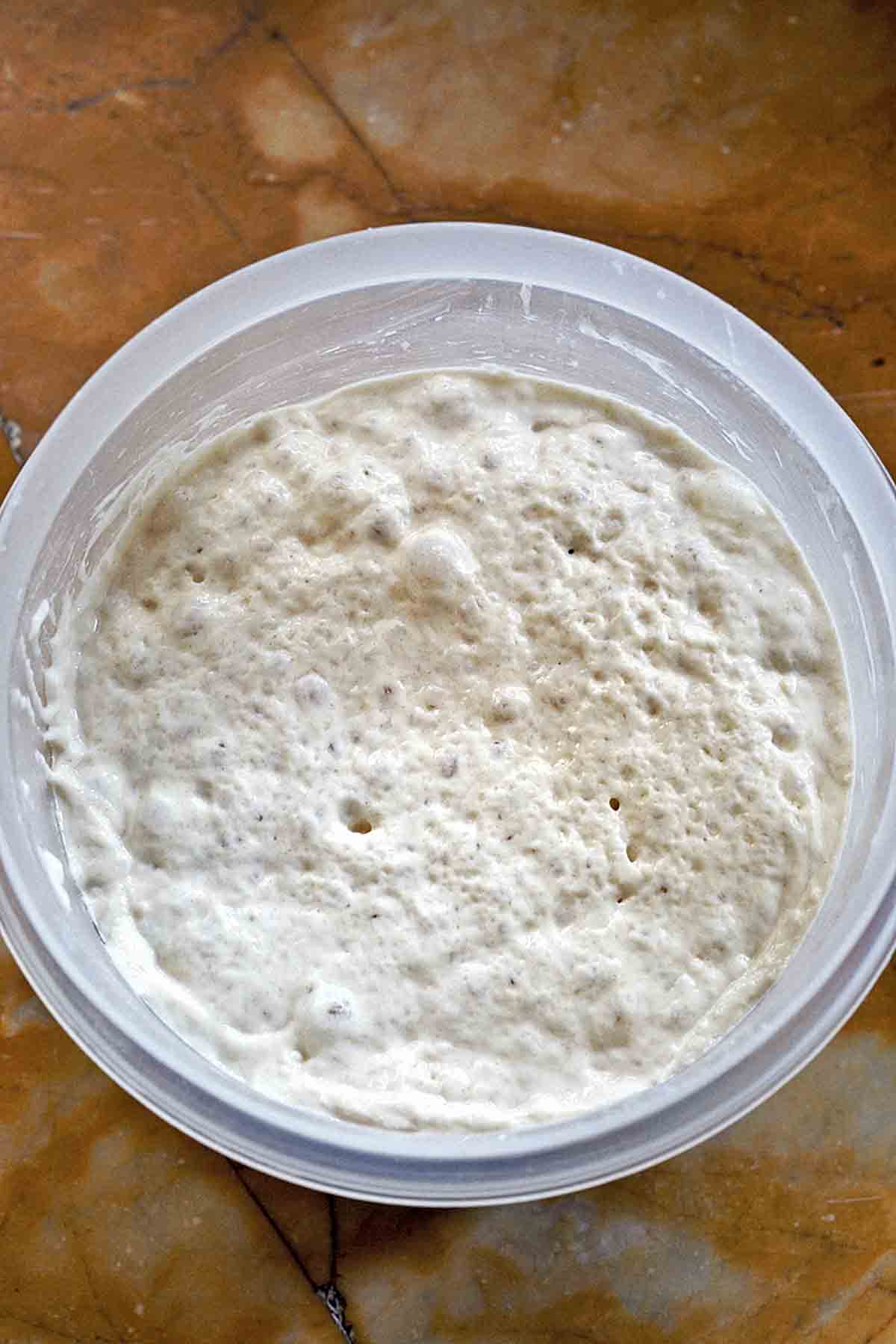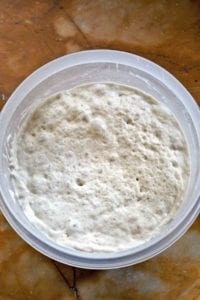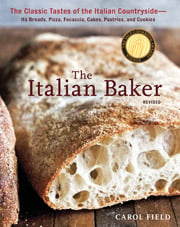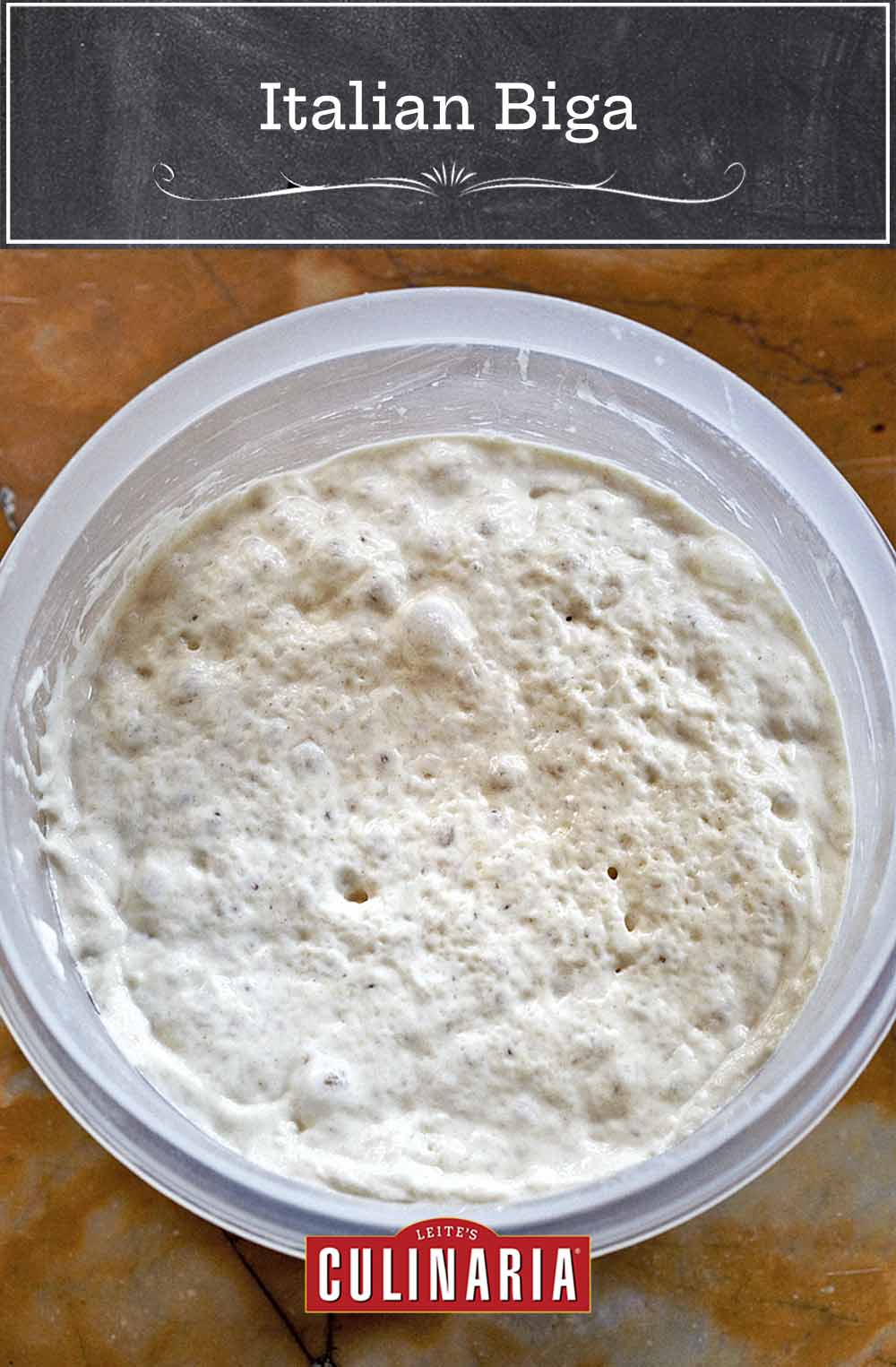
Many of the recipes for classic regional breads, such as this ciabatta recipe, begin with a starter dough made from small amounts of flour, water, and yeast allowed an initial fermentation. The starter, known as biga in Italy, or bighino when in small amounts, not only gives strength to what in Italy are weak flours, it also produces a secondary fermentation from which come the wonderful aroma, natural flavor, and special porosity of the final loaves and wheels of bread.
The important point about a biga is that the breads made with it develop a wonderful taste because their risings are long and bring out the flavor of the grain. Another benefit is that the loaves remain fresher and taste sweeter than those made with large amounts of commercial yeast.
In Italy, bakers use dough from the previous day’s baking to start a new dough. I keep some starter on hand at all times; by having it around, I can decide to make pane pugliese or ciabatta in the morning and have it for dinner that night. Because the first biga must come from somewhere, though, you may make it following the instructions below. It’s remarkable. It freezes very well and needs only about 3 hours at room temperature until it is bubbly and active again, or it can be refrigerated for up to 5 days.–Carol Field
LC Obliged to Biga Note
Behind each and every memorable bite of proper Italian bread we’ve daintily nibbled, hungrily inhaled, or otherwise somehow consumed, we have a biga to thank. So we’re feeling much obliged to Carol Field for this recipe. Nonna not included.

Italian Biga
Ingredients
- 1/4 teaspoon active dry yeast
- 1/4 cup warm water, 100°F to 110°F (38°C to 43°C)
- 3/4 cup plus 4 teaspoons bottled spring water, at room temperature (You can use tap water in a pinch.)
- 2 1/3 cups unbleached all-purpose flour
- vegetable oil, for the bowl
Instructions
- Stir the 1/4 teaspoon active dry yeast into the 1/4 cup warm water and let stand until creamy, about 10 minutes.
- Stir the 3/4 cup plus 4 teaspoons bottled spring water into the creamy yeast mixture, and then stir in the 2 1/3 cups unbleached all-purpose flour, 1 cup at a time. ☞ If mixing by hand, stir with a wooden spoon for 3 to 4 minutes. ☞ If mixing with a stand mixer, beat with the paddle at the lowest speed for 2 minutes. If mixing with a food processor, mix just until a sticky dough forms.
- Transfer the biga to a bowl lightly coated with vegetable oil, cover with plastic wrap, and let rise at cool room temperature for 6 to 24 hours, until the starter is triple its original volume but is still wet and sticky. (The bakers I admire most advise 10 to 11 hours for the first rise, but others are very happy with the 24 hours it takes for dough to truly become yesterday’s dough, and if you like sour bread, allow your biga to rest for 24 to 48 hours or even 72 hours.)
- Cover and refrigerate or freeze the biga until ready to use. (If refrigerating the biga, use within 5 days. If freezing the biga, let it rest at room temperature for about 3 hours until it is bubbly and active again.) When needed, scoop out the desired amount of biga for your recipe and proceed. I strongly recommend weighing the biga rather than measuring it by volume since it expands at room temperature. If measuring by volume, measure chilled biga; if measuring by weight, the biga may be chilled or at room temperature.

Nutrition
Nutrition information is automatically calculated, so should only be used as an approximation.
Recipe Testers’ Reviews
This is a perfectly suitable starting point for most any bread which uses a starter. I bake bread several times a week and it’s nice to have this handy. Sometimes I add this to a bread dough which doesn’t call for a starter just for the added flavor.












Hi, could you also post the yield in metric?
Hi Smith, you should end up with a little more than 500 grams of biga, just perfect for the ciabatta bread, https://leitesculinaria.com/79221/recipes-ciabatta.html
Some sympathy for the Australians in the earlier part of this discussion, some problems may be solved by understanding that an American Legal cup = 240 mls compared with Australian 250mls and an Australian tablespoon is 20ml compared to American 15ml. When a recipe has been converted to grams (including teaspoons tablespoons etc) this is a great help to the international audience.
John E, thanks for the reminder. We did include gram weights for this recipe especially because of these kind of issues. We didn’t convert the 1/4 teaspoon of dry yeast because that comes out to .71 grams and most scales aren’t that specific.
Depends on the yeast used, it comes in 7 or 8 gram sachets unless you use bulk yeast. Don’t muck about with .71 grams, 1_gram is close enough for government work.
This is the most comprehensive and yet simple discussion I’ve seen on Biga. Thank you for taking the mystery out of how to make Biga. Our Italian Breads we’ve been making rise nicely and have a good crust, but we are looking for larger holes and more flavor (pretty bland). We’ll be giving the Biga a try tomorrow for final baking on Sunday.
Question, the bread recipe calls for salt and we thought this would give the bread more flavor. Does salt negatively affect the yeast?
Also, what would you suggest for a heartier yeast flavored bread? Will the Biga give us the flavor we’re looking for. We’ve been using Bread flour and Red Star Platinum Instant Yeast.
Hi Mary, thanks so much for your kind words! Please let us know when you bake the bread if it gives you the hearty flavor that you desire. In the meantime, this is a great link that discusses the role of salt in bread baking. https://www.kingarthurflour.com/professional/salt.html
Thank you for your reply – interesting and good information on salt. Very helpful for a reference.
We have made the biga and it’s resting, probably will let it go for 15 to 18 hours. Will let you know how the Ciabatta turns out.
Question: If making a bread recipe that doesn’t call for Biga, but I want to add it in the recipe – how do I determine how much to put in as added ingredients. For ex. if it calls for 3 1/2 cups of flour, 12 oz. water, 1 1/2 tsp salt and 1/4 tsp of yeast – how much Biga do we put in? Is the Biga a substitution of the dough mixture (i.e. 1 cup of dough for 1 cup of Biga)?
Thanks very much.
Hi Mary, fingers crossed! We only tested the biga as a starter for the ciabatta but I understand that you can use it as you would a sourdough starter. Hope this helps.
Mary, I just add it to my dough as soon as I am done mixing it (the dough). A cup or so of any starter, biga, or aged dough can do nothing but improve the flavor of your bread….
Hi and thank you for the ciabatta recipe, I have saf instant yeast the red bag, will this yeast work and if yes, any changes to the amount for your recipe?
Thank you
Hi DG, you should be fine using SAF yeast for this recipe.
Salt slows down the fermentation rate of the yeast and helps in development of the flavor. One thing to bear in mind, never let salt come in direct contact with the yeast. I always mix flour, water and yeast and when it comes together let it rest for 20 minutes and then add and mix in the salt.